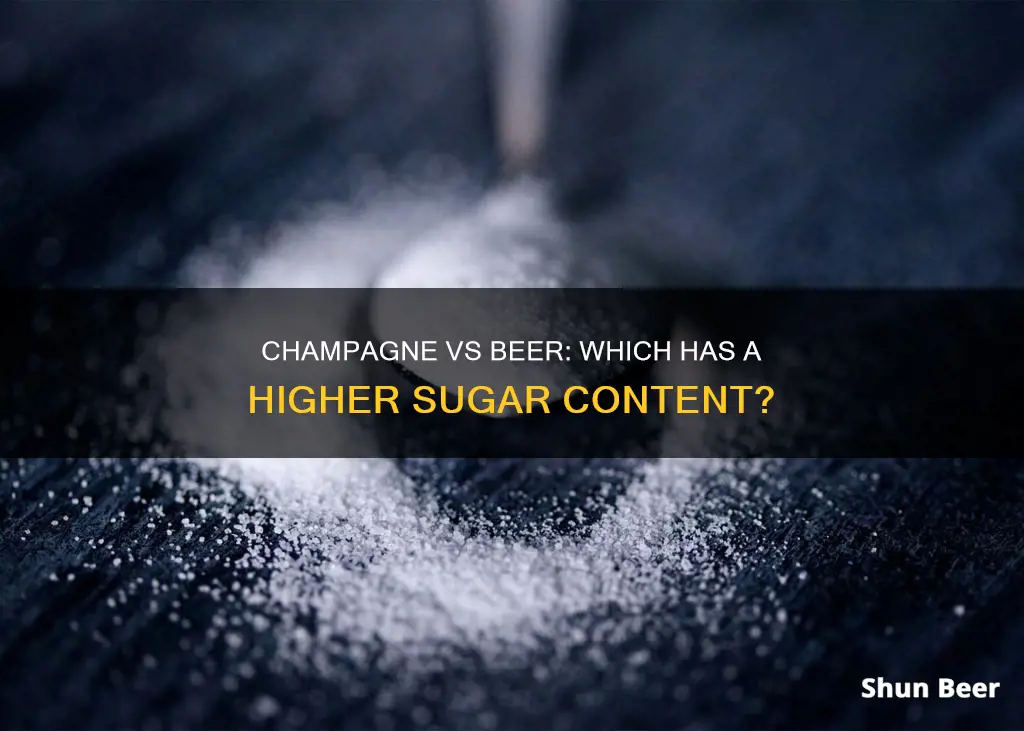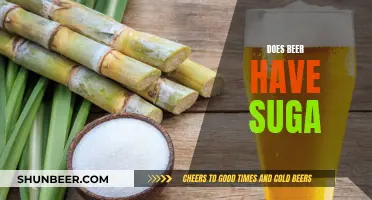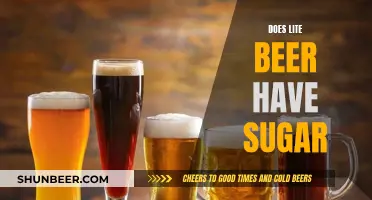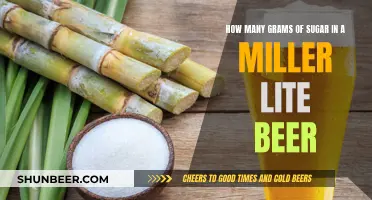
Champagne and beer are two very different alcoholic drinks, with distinct production processes and ingredients. Champagne, a sparkling wine from the Champagne region of France, is known for its elegance and association with celebrations. On the other hand, beer is a fermented beverage typically made from grains, water, hops, and yeast. While both contain alcohol, their sugar content can vary significantly. So, does champagne have more sugar than beer? Let's delve into the topic and explore the sugar levels in these beverages.
What You'll Learn
- Champagne's sugar content depends on its category: brut nature, extra brut, brut, extra dry, or demi-sec
- A typical bottle of non-vintage Champagne contains 6 to 12 grams of sugar per litre
- Champagne's sugar comes from the dosage added after the second fermentation
- Champagne's sweetness is influenced by the high acidity of the wine
- Champagne has fewer calories than beer

Champagne's sugar content depends on its category: brut nature, extra brut, brut, extra dry, or demi-sec
The sugar content of champagne depends on its style or category, which is determined by the dosage—a mixture of wine and sugar—added after the second fermentation. The different styles of champagne, from driest to sweetest, include:
Brut Nature, Dosage Zéro, or Pas Dosé
Champagne labelled as "Brut Nature", "Dosage Zéro", or "Pas Dosé" has no added sugar and contains less than 3 grams of sugar per litre, with some sources specifying a range of 0 to 3 grams of residual sugar per litre.
Extra Brut
The "Extra Brut" style of champagne has very low sugar content, ranging from 0 to 6 grams of residual sugar per litre.
Brut
"Brut" champagnes are considered dry, with little residual sugar. They typically contain less than 12 grams of sugar per litre, with some sources specifying a range of 6 to 12 grams of sugar per litre.
Extra Dry
The "Extra Dry" style falls in the middle of the sweetness spectrum, being slightly sweeter than Brut. It contains between 12 and 17 grams of residual sugar per litre.
Sec
"Sec" champagnes are noticeably sweet and contain between 17 and 32 grams of sugar per litre.
Demi-Sec
The "Demi-Sec" style is even sweeter, with a sugar content ranging from 32 to 50 grams of residual sugar per litre.
Beer and Sugar: What's the Connection?
You may want to see also

A typical bottle of non-vintage Champagne contains 6 to 12 grams of sugar per litre
Champagne, a sparkling wine from the Champagne region of France, is often associated with celebrations and elegance. While it is perceived as a luxury beverage, it does contain sugar. The amount of sugar in Champagne can vary significantly, influencing not only its taste but also its categorization.
The sugar content in Champagne ranges from the ultra-brut, which has almost no sugar, to the richly sweet doux variety. It is important to note that the presence of sugar in Champagne doesn't necessarily make it taste sweet. The high acidity of the wine can balance the sweetness, resulting in a harmonious flavour profile.
Champagne labels can provide information about the sweetness level and whether it is a non-vintage or vintage Champagne. Non-vintage Champagnes, indicated by the label "NV", are blends of grapes from different years, while vintage Champagnes are made from grapes of a single year's harvest.
When it comes to sugar content, it's worth noting that Champagne is not necessarily higher in sugar than regular still wines. Both Champagne and still wines can vary widely in their sugar content, and some dry table wines may contain less sugar than even the driest Champagnes.
Sweetening Carbonated Beer: Sugar Quantity for 16 Oz
You may want to see also

Champagne's sugar comes from the dosage added after the second fermentation
The sugar content in Champagne is a result of the dosage, a mixture of wine and sugar, added after the second fermentation. This dosage is crucial for winemakers to adjust the sweetness of the final product. The level of sugar in a glass of Champagne can vary, ranging from the ultra-brut, with almost no sugar, to the doux variety, which is notably sweeter. The presence of sugar in Champagne does not necessarily make it taste sweet, as the high acidity of the wine balances out the sweetness, resulting in a harmonious flavour profile.
The dosage added after the second fermentation plays a significant role in determining the sweetness of Champagne. The sugar content in Champagne can be as low as zero grams per litre in the case of 'Zero Dosage' or ''Brut Nature' varieties, or it can go up to more than 50 grams per litre in the case of the Doux variety. The amount of dosage added is carefully calibrated to achieve the desired level of sweetness.
The process of adding dosage after the second fermentation is a well-established practice in winemaking. It allows winemakers to fine-tune the flavour profile of their Champagne. The type of sugar added can vary, with some producers opting for beet sugar, cane sugar, or a product called 'MCR' (rectified and concentrated grape must). The wine used in the dosage is also important and can be a young still wine or the same base wine used in the Champagne.
The dosage is added after the second fermentation, which takes place in the bottle. This fermentation occurs under challenging conditions of growing pressure, cold temperatures, and rising alcohol levels. An especially tough strain of yeast is used to ferment the sugar, and this yeast consumes most of the sugar added. However, a small amount of residual sugar can remain, even in Champagnes labelled as having zero dosage.
The sugar content in Champagne is an essential aspect of its history, identity, and style. While the amount of sugar added during dosage can vary, the tiny amounts found in most Champagnes today are not something to be concerned about. In fact, these sugars play a crucial role in the ageing process, contributing to the unique character of aged Champagne.
Beer and Blood Sugar: What's the Connection?
You may want to see also

Champagne's sweetness is influenced by the high acidity of the wine
Champagne, a sparkling wine from the Champagne region of France, is known for its quality and elegance. While it is often perceived as a luxury beverage devoid of sweetness, the truth is that it does contain sugar, and the amount can vary significantly. The sugar in Champagne comes from the dosage, a mixture of wine and sugar added after the second fermentation, which occurs in the bottle. This dosage is crucial for adjusting the sweetness of the final product.
The level of sweetness in Champagne can range from ultra-brut, with almost no sugar, to the richly sweet doux variety. However, it's important to note that the presence of sugar in Champagne doesn't necessarily make it taste sweet. This is because the high acidity of the wine balances the sweetness, creating a harmonious flavour profile. In other words, the more acidic a wine is, the less obvious its sweetness will be.
Acidity is one of the fundamental traits of wine, along with tannin, alcohol, and sweetness. It gives wine its tart and sour taste. All wines fall on the acidic side of the pH spectrum, typically ranging from 2.5 to 4.5 pH, with 7 being neutral. The most common acids found in wine include tartaric, malic, and citric acid. Acidity is essential for wine quality, as it helps to preserve the wine longer. As wines age, the acidity acts as a buffer, allowing them to age gracefully.
In Champagne, the average acid levels have been decreasing due to climate change. Grapes in the Champagne region have been getting riper, resulting in lower acid levels. This has led to a reduced need for added sugar to compensate for the traditionally high acidity of grapes grown in cooler climates. The final residual sugar levels in Champagne can vary, with some champagnes having no added sugar at all, resulting in a Brut Nature or Ultra Brut classification.
Sour Beers: High Sugar Content or Healthy Choice?
You may want to see also

Champagne has fewer calories than beer
The perception that Champagne is a luxury beverage devoid of sweetness is not entirely accurate. Champagne does contain sugar, and the amount can vary significantly, influencing both its taste and categorisation. The sugar in Champagne is added after the second fermentation, which occurs in the bottle, and it's essential for adjusting the sweetness of the final product. The level of sweetness in Champagne can range from ultra-brut, with almost no sugar, to the sweet variety known as doux.
The sweetness of Champagne is categorised using terms like Brut Nature, Extra Brut, Brut, Extra Dry, and Demi-Sec. Brut Nature has the least amount of sugar, with less than 3 grams per litre, while Demi-Sec has the most. It's worth noting that the presence of sugar in Champagne doesn't necessarily make it taste sweet, as the high acidity of the wine can balance the sweetness.
Champagne expert Chantelle Corbo notes that 90% of Champagnes are dosed as brut, containing less than 15 grams of sugar per litre, or about 2 grams of sugar per 5-ounce glass. This is significantly lower than the sugar content of other beverages. For example, a 16-ounce bottle of kombucha has an average of 10 grams of sugar, which is similar to the amount in a 5-ounce serving.
When it comes to health, Champagne has some surprising benefits. According to NYC-based nutritionist and registered dietitian Tanya Zuckerbrot, the bubbles in Champagne slow down consumption time and create a feeling of fullness. Therefore, opting for Champagne over other alcoholic drinks throughout the night can save you hundreds of calories. Additionally, Champagne contains fewer calories than wine, making it a relatively diet-friendly option when consumed in moderation.
Beer and Blood Sugar: A Dangerous Mix?
You may want to see also
Frequently asked questions
It depends on the type of beer and the type of champagne. A typical bottle of non-vintage champagne contains between 6 to 12 grams of sugar per liter, while a 16-oz bottle of beer typically has around 10 grams of sugar. However, some champagnes can have up to 50 grams of sugar per liter, which would be more than most beers.
The sugar content in champagne is determined by the dosage, which is the amount of sugar added after the second fermentation. The dosage can vary depending on the desired sweetness and style of the champagne.
From driest to sweetest, the types of champagne are: Brut Nature, Extra Brut, Brut, Extra Dry, Sec, and Demi-Sec.
A 5-ounce serving of champagne has a lower sugar content than most other beverages. For example, a 5-ounce serving of Brut Nature sparkling wine has 0.5 grams of sugar, while a 5-ounce serving of Starbucks 2% Milk Grande Latte has 17 grams of sugar.
The high acidity of champagne can balance out the sweetness, so a champagne with more sugar may not necessarily taste sweeter. The sugar content also influences the flavor and texture of the champagne, and can affect its ageability and balance.







